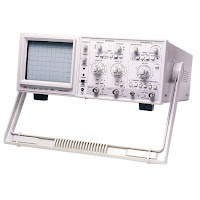 Minipa MO 1225 – Icel OS 21 - 25MHz – Dual trace oscilloscope – calibration procedure
Minipa MO 1225 – Icel OS 21 - 25MHz – Dual trace oscilloscope – calibration procedure
Icel
OS 21, Mesco AO 1221, Minipa MO 1225, YB4328 – 20 – 25MHz Oscilloscope
20MHz/15MHz series oscilloscope is a portable kind of oscilloscope
for two traces. The bandwidth of 20MHz is 0~20MHz. And 15MHz is of long persistence and slow sweeping with its
bandwidth of 0~15MHz, its vertical deflection
factor is 5mV/div and to 1mV/div by Magnification. Full bandwidth sweeping
circuit is used in the sweeping system. The flexible and convenient triggering
mode has the functions for selecting signals from one channel or triggered by
Ext signals. And there is another function of ALT trigger to observe signals
from two irrelative channels. The instrument has the functions of TV-V
synchronization and trigger-lock to observe all kinds of signals stably. And
from the terminal for trigger input, CH1 and CH2 signals can be output along
with the triggering channel to connect the Ext frequency counter. 15MHz has the
lowest rate of 10s/div and the longest time is 250s every time. The instrument
is of easy operation with comfortable controllers. Its reasonable structure and
technology makes it conveniently to repair and calibrate.
Performance Test and Calibration of
the Instrument
In order to keep the instrument to be in the best working state
after repair or used for a long time, it should be thoroughly checked and
calibrated. And the positions of the elements needing calibration.
Position Diagram of Elements needing Calibration
Calibration of CRT Display System
Adjust the controllers on the operating panel to get sweep
baseline on the screen at moderate sweep speed. Rotate INTE potential to the
point on one third of the full, adjust 5R27 to get the persistence. Then move
the sweep baseline to the up and bottom line, adjust 5R29 in order that there
is no clear distortion of the waveform.
Rotate SEC/DIV counterclockwise to X-Y mode, adjust POSITION to
get one bright dot displayed on the screen with adjusting FOCUS and 5R43 at the
same time, then the trace would be fine and round.
Adjustment of Probe Calibrating System
Signals
Input the signal of standard amplitude and the signal for probe calibration to
the same channel separately. Measure out their difference by comparison. Adjust
7R13 to make the difference the smallest. Then adjust 7R9 to get the
symmetrical waveform. Test its frequency by a frequency counter. Adjust 7R7 to
get the smallest difference.
Adjustment of Vertical System
Calibration of DC Symmetry
One controller knob on the
operating panel. The sweep baseline of Y1 channel is displayed on the screen.
Adjust 1R77 to get the smallest position in vertical axis when VARIABLE is
rotated. Calibrate DC symmetry of Y2 channel by the same method. 1R81 should be
adjusted.
Calibrate Y Gain
Vertical Mode is set to Y1, and VOLTS/DIV is set to 0.1V. Rotate
VARIABLE clockwise to the end. Input the signal for probe calibration. Adjust
1R79 to get the displayed amplitude be 5DIV. Switch VOLTS/DIV to 0.5V, push
down Y1×. Then adjust 1R80 to get the displayed amplitude be 5DIV.
Calibrate Y2 Gain using the same method by adjusting 1R83 and 1R84.
Calibration for Y-Axis Attenuate Frequency Compensation
Input standard square wave of 1kHz to two vertical channels.
According to the attenuated waveform shown on Figure, adjust the relative
elements from small to big to get correct compensation.
Element Position
Needing Adjustment
Calibration of Vertical Instantaneity
Set VOLTS/DIV of two vertical channels to 5mV, rotate VARIABLE
clockwise to the end. Input a square waveform with its rising time ≤1ns to the vertical channels, connect a terminal resistance of
50Ω to the input terminal of the channel. Adjust the signal amplitude to get
the displayed amplitude be 5DIV. Repeat adjusting 1C8 (CH1)、 1C17、 1C18 (CH2)、 2C2、 2C7 to get the best compensation
shown as Figure, the rising time is ≤18ns.
Calibration of Horizontal System
Calibration of Sweep Rate Set SEC/DIV to 0.5ms, rotate VARIABLE
clockwise to the end. Input a standard timebase signal of 0.5ms, adjust 4R53 to
get one cycle per DIV on the screen. Push down MAG ×5 and adjust 4R54 to get one cycle per 5DIV on the screen. Spring
out MAG ×5, switch SEC/DIV to 0.2ms. the signal would change with it. Adjust
4C20 to get one cycle per DIV displayed on the screen. Check every sweep
sequence to make the accuracy of each sequence more than ±5%.
When the sweep rate is set as very fast, adjust 4C29 to get
compensation at the beginning. Be careful for all these adjustments interact
with each other.
Adjustment of X-Y Mode
Calibration of X-Axis Symmetry
Set SEC/DIV to X-Y mode. Adjust X POSITION. The cursor would move
out of the screen from left or right, or adjust 4R2.
X Gain Calibration
Set CH1 (X) VOLTS/DIV to 0.1V and input the standard calibrating
signal. Adjust 4R9 to get two cursors with its distance 5DIV horizontally
displayed on the screen.
The standard used in the instrument: EN61010-1(1993) Safety requirements for electrical equipment for
measurement, control, and laboratory use.




